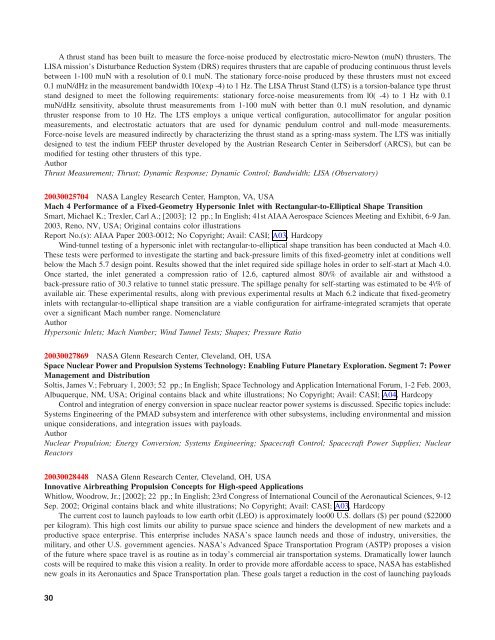You also want an ePaper? Increase the reach of your titles
YUMPU automatically turns print PDFs into web optimized ePapers that Google loves.
A thrust stand has been built to measure the force-noise produced by electrostatic micro-Newton (muN) thrusters. The<br />
LISA mission’s Disturbance Reduction System (DRS) requires thrusters that are capable of producing continuous thrust levels<br />
between 1-100 muN with a resolution of 0.1 muN. The stationary force-noise produced by these thrusters must not exceed<br />
0.1 muN/dHz in the measurement bandwidth 10(exp -4) to 1 Hz. The LISA Thrust Stand (LTS) is a torsion-balance type thrust<br />
stand designed to meet the following requirements: stationary force-noise measurements from l0( -4) to 1 Hz with 0.1<br />
muN/dHz sensitivity, absolute thrust measurements from 1-100 muN with better than 0.1 muN resolution, and dynamic<br />
thruster response from to 10 Hz. The LTS employs a unique vertical configuration, autocollimator for angular position<br />
measurements, and electrostatic actuators that are used for dynamic pendulum control and null-mode measurements.<br />
Force-noise levels are measured indirectly by characterizing the thrust stand as a spring-mass system. The LTS was initially<br />
designed to test the indium FEEP thruster developed by the Austrian Research Center in Seibersdorf (ARCS), but can be<br />
modified for testing other thrusters of this type.<br />
Author<br />
Thrust Measurement; Thrust; Dynamic Response; Dynamic Control; Bandwidth; LISA (Observatory)<br />
20030025704 NASA Langley Research Center, Hampton, VA, USA<br />
Mach 4 Performance of a Fixed-Geometry Hypersonic Inlet with Rectangular-to-Elliptical Shape Transition<br />
Smart, Michael K.; Trexler, Carl A.; [2003]; 12 pp.; In English; 41st AIAA Aerospace Sciences Meeting and Exhibit, 6-9 Jan.<br />
2003, Reno, NV, USA; Original contains color illustrations<br />
Report No.(s): AIAA Paper 2003-0012; No Copyright; Avail: CASI; A03, Hardcopy<br />
Wind-tunnel testing of a hypersonic inlet with rectangular-to-elliptical shape transition has been conducted at Mach 4.0.<br />
These tests were performed to investigate the <strong>star</strong>ting and back-pressure limits of this fixed-geometry inlet at conditions well<br />
below the Mach 5.7 design point. Results showed that the inlet required side spillage holes in order to self-<strong>star</strong>t at Mach 4.0.<br />
Once <strong>star</strong>ted, the inlet generated a compression ratio of 12.6, captured almost 80\% of available air and withstood a<br />
back-pressure ratio of 30.3 relative to tunnel static pressure. The spillage penalty for self-<strong>star</strong>ting was estimated to be 4\% of<br />
available air. These experimental results, along with previous experimental results at Mach 6.2 indicate that fixed-geometry<br />
inlets with rectangular-to-elliptical shape transition are a viable configuration for airframe-integrated scramjets that operate<br />
over a significant Mach number range. Nomenclature<br />
Author<br />
Hypersonic Inlets; Mach Number; Wind Tunnel Tests; Shapes; Pressure Ratio<br />
20030027869 NASA Glenn Research Center, Cleveland, OH, USA<br />
Space Nuclear Power and Propulsion Systems Technology: Enabling Future Planetary Exploration. Segment 7: Power<br />
Management and Distribution<br />
Soltis, James V.; February 1, 2003; 52 pp.; In English; Space Technology and Application International Forum, 1-2 Feb. 2003,<br />
Albuquerque, NM, USA; Original contains black and white illustrations; No Copyright; Avail: CASI; A04, Hardcopy<br />
Control and integration of energy conversion in space nuclear reactor power systems is discussed. Specific topics include:<br />
Systems Engineering of the PMAD subsystem and interference with other subsystems, including environmental and mission<br />
unique considerations, and integration issues with payloads.<br />
Author<br />
Nuclear Propulsion; Energy Conversion; Systems Engineering; Spacecraft Control; Spacecraft Power Supplies; Nuclear<br />
Reactors<br />
20030028448 NASA Glenn Research Center, Cleveland, OH, USA<br />
Innovative Airbreathing Propulsion Concepts for High-speed Applications<br />
Whitlow, Woodrow, Jr.; [2002]; 22 pp.; In English; 23rd Congress of International Council of the Aeronautical Sciences, 9-12<br />
Sep. 2002; Original contains black and white illustrations; No Copyright; Avail: CASI; A03, Hardcopy<br />
The current cost to launch payloads to low earth orbit (LEO) is approximately loo00 U.S. dollars ($) per pound ($22000<br />
per kilogram). This high cost limits our ability to pursue space science and hinders the development of new markets and a<br />
productive space enterprise. This enterprise includes NASA’s space launch needs and those of industry, universities, the<br />
military, and other U.S. government agencies. NASA’s Advanced Space Transportation Program (ASTP) proposes a vision<br />
of the future where space travel is as routine as in today’s commercial air transportation systems. Dramatically lower launch<br />
costs will be required to make this vision a reality. In order to provide more affordable access to space, NASA has established<br />
new goals in its Aeronautics and Space Transportation plan. These goals target a reduction in the cost of launching payloads<br />
30
















